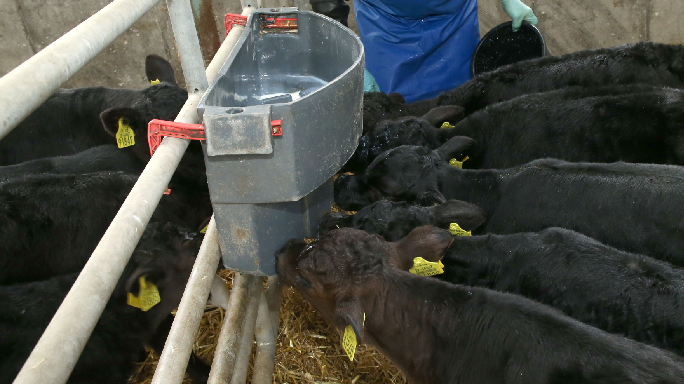The benefits of feeding high quality calf milk replacer

Saleable whole milk can have a higher energy density compared with calf milk replacer and is superior in terms of digestibility, particularly in calves under 3 weeks of age.
However, it can be more expensive to feed whole milk when compared to saleable milk prices plus a greater risk of disease transmission such as Johne’s disease. Currently, when comparing cost of milk replacer per litre mixed to the current milk price it makes economic sense to feed calf milk replacer.
When the calf milk replacer is formulated correctly from good-quality ingredients and fed according to the manufacture’s instructions, Teagasc research shows that calves can grow equally well when reared on CMR just as well as they would on whole milk diets. Benefits of feeding calf milk replacer are the consistency of the energy and vitamin and mineral content of the feed and the lower disease risk. Calves thrive on consistency. Additional benefits to feeding milk replacers includes feeding at a more convenient time and can be labour saving.
When it comes to choosing calf milk replacers it is important to assess the quality of the constituents you are feeding. Here are some key questions to ask before making a purchase.
- What is the dairy protein source?
- Is the protein source of good quality (plant or dairy)?
- What is the energy content?
- Is the milk powder easily digestible?
Protein
Commercial milk replacers usually contain 20–26 % protein. Protein sources in milk powder can be of milk origin (skimmed milk or whey), egg based or plant based (e.g soya, Wheat gluten, peas). Young calves can only digest proteins of milk origin therefore, it is important that the calf milk replacer contains predominantly milk derived proteins from whey and/or skimmed milk.
Energy
Milk replacers should contain 15–20% fat. Energy source in milk replacers are fat and lactose. Vegetable fats such as palm oil, coconut oil, linseed oil, sunflower oil. Fats are emulsified to a greater or lesser extent in the manufacturing process. The more emulsified a fat is, the more digestible it will be. One of the main advantages of feeding milk replacer over whole milk is the fact that calves fed milk replacer can consume 33% more concentrates over the rearing phase. This is due to the fat content of whole milk is always higher and gives the calf a fuller feeling throughout the day.
Digestibility
Where protein and fat sources are not balanced, some vegetable proteins such as soya and wheat gluten can result in nutritional scours and limit growth, feed efficiency and digestibility. High levels of vegetable fats such as coconut, palm oil or soybean can also pose a risk of scour to calves under 2 weeks of age. Fibre content of a calf milk replacer is considered an indicator of protein quality. High-quality calf milk replacers have a fibre content of less than 0.15%. Fibre originates from plant material used to increase protein levels in milk replacers. For every 0.1% increase in fibre content in replacers, about 10% of the total protein has been derived from plant, rather than milk sources. Additionally, cheaper plant-based sources do not provide proper amino acids profiles needed for calf growth.
For any further information on the topic covered please contact your local Glanbia Ireland representative.
First Published 10 January 2022
Tagged with: Dairy
